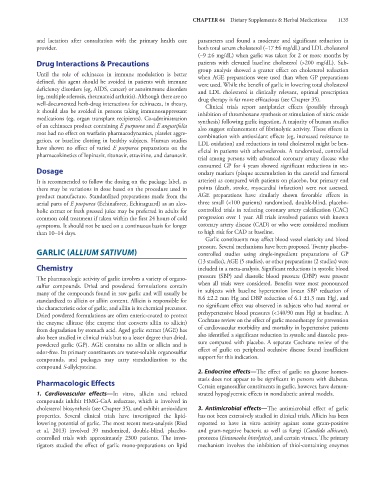Page 1149 - Basic _ Clinical Pharmacology ( PDFDrive )
P. 1149
CHAPTER 64 Dietary Supplements & Herbal Medications 1135
and lactation after consultation with the primary health care parameters and found a moderate and significant reduction in
provider. both total serum cholesterol (–17 ±6 mg/dL) and LDL cholesterol
(–9 ±6 mg/dL) when garlic was taken for 2 or more months by
Drug Interactions & Precautions patients with elevated baseline cholesterol (>200 mg/dL). Sub-
group analysis showed a greater effect on cholesterol reduction
Until the role of echinacea in immune modulation is better when AGE preparations were used than when GP preparations
defined, this agent should be avoided in patients with immune were used. While the benefit of garlic in lowering total cholesterol
deficiency disorders (eg, AIDS, cancer) or autoimmune disorders and LDL cholesterol is clinically relevant, optimal prescription
(eg, multiple sclerosis, rheumatoid arthritis). Although there are no drug therapy is far more efficacious (see Chapter 35).
well-documented herb-drug interactions for echinacea, in theory, Clinical trials report antiplatelet effects (possibly through
it should also be avoided in persons taking immunosuppressant inhibition of thromboxane synthesis or stimulation of nitric oxide
medications (eg, organ transplant recipients). Co-administration synthesis) following garlic ingestion. A majority of human studies
of an echinacea product containing E purpurea and E angustifolia also suggest enhancement of fibrinolytic activity. These effects in
root had no effect on warfarin pharmacodynamics, platelet aggre- combination with antioxidant effects (eg, increased resistance to
gation, or baseline clotting in healthy subjects. Human studies LDL oxidation) and reductions in total cholesterol might be ben-
have shown no effect of varied E purpurea preparations on the eficial in patients with atherosclerosis. A randomized, controlled
pharmacokinetics of lopinavir, ritonavir, etravirine, and darunavir.
trial among persons with advanced coronary artery disease who
consumed GP for 4 years showed significant reductions in sec-
Dosage ondary markers (plaque accumulation in the carotid and femoral
It is recommended to follow the dosing on the package label, as arteries) as compared with patients on placebo, but primary end
there may be variations in dose based on the procedure used in points (death, stroke, myocardial infarction) were not assessed.
product manufacture. Standardized preparations made from the AGE preparations have similarly shown favorable effects in
aerial parts of E purpurea (Echinaforce, Echinaguard) as an alco- three small (<100 patients) randomized, double-blind, placebo-
holic extract or fresh pressed juice may be preferred in adults for controlled trials in reducing coronary artery calcification (CAC)
common cold treatment if taken within the first 24 hours of cold progression over 1 year. All trials involved patients with known
symptoms. It should not be used on a continuous basis for longer coronary artery disease (CAD) or who were considered medium
than 10–14 days. to high risk for CAD at baseline.
Garlic constituents may affect blood vessel elasticity and blood
pressure. Several mechanisms have been proposed. Twenty placebo-
GARLIC (ALLIUM SATIVUM) controlled studies using single-ingredient preparations of GP
(13 studies), AGE (5 studies), or other preparations (2 studies) were
Chemistry included in a meta-analysis. Significant reductions in systolic blood
The pharmacologic activity of garlic involves a variety of organo- pressure (SBP) and diastolic blood pressure (DBP) were present
sulfur compounds. Dried and powdered formulations contain when all trials were considered. Benefits were most pronounced
many of the compounds found in raw garlic and will usually be in subjects with baseline hypertension (mean SBP reduction of
standardized to allicin or alliin content. Allicin is responsible for 8.6 ±2.2 mm Hg and DBP reduction of 6.1 ±1.3 mm Hg), and
the characteristic odor of garlic, and alliin is its chemical precursor. no significant effect was observed in subjects who had normal or
Dried powdered formulations are often enteric-coated to protect prehypertensive blood pressures (<140/90 mm Hg) at baseline. A
the enzyme allinase (the enzyme that converts alliin to allicin) Cochrane review on the effect of garlic monotherapy for prevention
from degradation by stomach acid. Aged garlic extract (AGE) has of cardiovascular morbidity and mortality in hypertensive patients
also been studied in clinical trials but to a lesser degree than dried, also identified a significant reduction in systolic and diastolic pres-
powdered garlic (GP). AGE contains no alliin or allicin and is sure compared with placebo. A separate Cochrane review of the
odor-free. Its primary constituents are water-soluble organosulfur effect of garlic on peripheral occlusive disease found insufficient
compounds, and packages may carry standardization to the support for this indication.
compound S-allylcysteine.
2. Endocrine effects—The effect of garlic on glucose homeo-
Pharmacologic Effects stasis does not appear to be significant in persons with diabetes.
Certain organosulfur constituents in garlic, however, have demon-
1. Cardiovascular effects—In vitro, allicin and related strated hypoglycemic effects in nondiabetic animal models.
compounds inhibit HMG-CoA reductase, which is involved in
cholesterol biosynthesis (see Chapter 35), and exhibit antioxidant 3. Antimicrobial effects—The antimicrobial effect of garlic
properties. Several clinical trials have investigated the lipid- has not been extensively studied in clinical trials. Allicin has been
lowering potential of garlic. The most recent meta-analysis (Ried reported to have in vitro activity against some gram-positive
et al, 2013) involved 39 randomized, double-blind, placebo- and gram-negative bacteria as well as fungi (Candida albicans),
controlled trials with approximately 2300 patients. The inves- protozoa (Entamoeba histolytica), and certain viruses. The primary
tigators studied the effect of garlic mono-preparations on lipid mechanism involves the inhibition of thiol-containing enzymes

